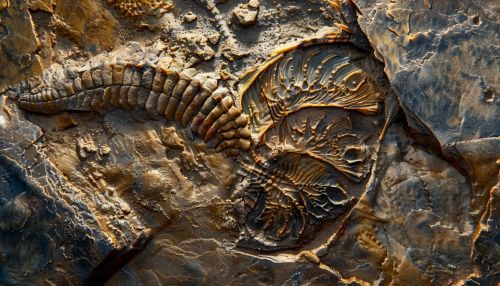Fossilization
Introduction
Fossilization is a complex process that involves the preservation of remains or traces of organisms from past geological ages. It provides a window into the history of life on Earth, allowing scientists to study extinct species and understand the evolution of current ones. The process of fossilization involves several stages, including death, decay, preservation, and discovery, each of which plays a crucial role in the formation of a fossil.
Types of Fossilization
There are several types of fossilization, each of which preserves different aspects of an organism. These include permineralization, replacement, recrystallization, carbonization, and molds and casts.
Permineralization
Permineralization is a process where mineral deposits form internal casts of organisms. The minerals seep into the porous material and form a cast in the organism's shape, preserving it with great detail. This process is common in the fossilization of plants and animals.
Replacement and Recrystallization
Replacement and recrystallization are similar processes that involve the replacement of the original material of an organism with minerals. In replacement, the original material is replaced with a different mineral, while in recrystallization, the same mineral is used but in a different crystalline form.
Carbonization
Carbonization is a process where the volatile substances of an organism are eliminated, leaving behind a carbon residue. This process is common in the fossilization of plants and soft-bodied organisms.
Molds and Casts
Molds and casts are a form of fossilization where the organism leaves an imprint in the sediment, which hardens and forms a mold. If this mold is later filled with other minerals, it forms a cast.


Conditions for Fossilization
Fossilization is a rare event as it requires specific conditions. These include rapid burial, lack of oxygen, and the presence of hard parts in an organism.
Rapid Burial
Rapid burial is essential for fossilization as it protects the remains from scavengers and weathering. This can occur due to natural disasters such as volcanic eruptions or landslides.
Lack of Oxygen
A lack of oxygen (anoxic conditions) is crucial for fossilization as it slows down the decay process. This can occur in environments such as deep oceans or bogs.
Presence of Hard Parts
Organisms with hard parts such as bones, shells, or teeth are more likely to fossilize as these materials are more resistant to decay.
Fossil Discovery and Study
The discovery and study of fossils involve several steps, including fieldwork, laboratory analysis, and interpretation. Paleontologists, scientists who study fossils, use various tools and techniques to uncover and analyze fossils.
Fieldwork
Fieldwork involves the search and excavation of fossils. Paleontologists often use geological maps and satellite images to locate potential fossil sites.
Laboratory Analysis
Once a fossil is found, it is brought to a laboratory for further analysis. This can involve cleaning the fossil, studying it under a microscope, and using various imaging techniques to reveal more details.
Interpretation
The interpretation of fossils involves understanding what the fossil tells us about the organism it came from and the environment it lived in. This can involve comparing the fossil to modern organisms, studying the rock layers it was found in, and using dating techniques to determine its age.
Importance of Fossils
Fossils play a crucial role in our understanding of Earth's history. They provide evidence of the existence of extinct species, help us understand the evolution of current species, and provide insights into past climates and environments.
